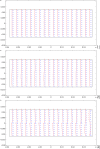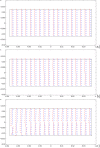An orthotropic continuum model with substructure evolution for describing bone remodeling: an interpretation of the primary mechanism behind Wolff's law
- PMID: 37542620
- PMCID: PMC10613191
- DOI: 10.1007/s10237-023-01755-w
An orthotropic continuum model with substructure evolution for describing bone remodeling: an interpretation of the primary mechanism behind Wolff's law
Abstract
We propose a variational approach that employs a generalized principle of virtual work to estimate both the mechanical response and the changes in living bone tissue during the remodeling process. This approach provides an explanation for the adaptive regulation of the bone substructure in the context of orthotropic material symmetry. We specifically focus upon the crucial gradual adjustment of bone tissue as a structural material that adapts its mechanical features, such as materials stiffnesses and microstructure, in response to the evolving loading conditions. We postulate that the evolution process relies on a feedback mechanism involving multiple stimulus signals. The mechanical and remodeling behavior of bone tissue is clearly a complex process that is difficult to describe within the framework of classical continuum theories. For this reason, a generalized continuum elastic theory is employed as a proper mathematical context for an adequate description of the examined phenomenon. To simplify the investigation, we considered a two-dimensional problem. Numerical simulations have been performed to illustrate bone evolution in a few significant cases: the bending of a rectangular cantilever plate and a three-point flexure test. The results are encouraging because they can replicate the optimization process observed in bone remodeling. The proposed model provides a likely distribution of stiffnesses and accurately represents the arrangement of trabeculae macroscopically described by the orthotropic symmetry directions, as supported by experimental evidence from the trajectorial theory.
Keywords: Bone functional adaptation; Bone remodeling; Growth/resorption processes; Orthotropic constitutive law; Variational formulation.
© 2023. The Author(s).
Conflict of interest statement
The authors declare that they have no conflict of interest.
Figures
















References
-
- Abdoul-Anziz H, Seppecher P. Strain gradient and generalized continua obtained by homogenizing frame lattices. Math Mech Complex Syst. 2018;6(3):213–250. doi: 10.2140/memocs.2018.6.213. - DOI
-
- Abdoul-Anziz H, Seppecher P, Bellis C. Homogenization of frame lattices leading to second gradient models coupling classical strain and strain-gradient terms. Math Mech Solids. 2019;24(12):3976–3999. doi: 10.1177/1081286519855431. - DOI
-
- Allena R, Cluzel C. Heterogeneous directions of orthotropy in three-dimensional structures: finite element description based on diffusion equations. Math Mech Complex Syst. 2018;6(4):339–351. doi: 10.2140/memocs.2018.6.339. - DOI
-
- Andres J, Bersani AM, Leśniak K. On some almost-periodicity problems in various metrics. Acta Applicandae Mathematica. 2001;65:35–57. doi: 10.1023/A:1010658802322. - DOI
-
- Barchiesi E, Hamila N. Maximum mechano-damage power release-based phase-field modeling of mass diffusion in damaging deformable solids. Z Angew Math Phys. 2022;73(1):35. doi: 10.1007/s00033-021-01668-7. - DOI
MeSH terms
LinkOut - more resources
Full Text Sources

